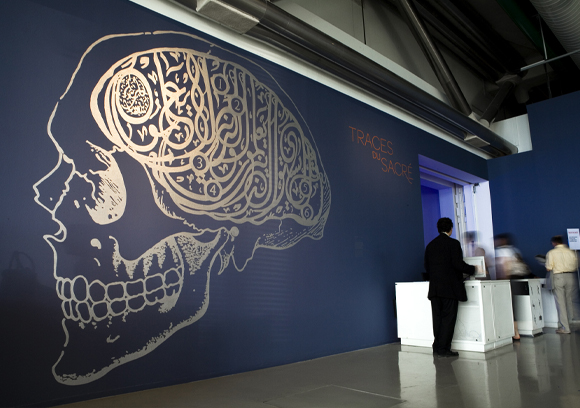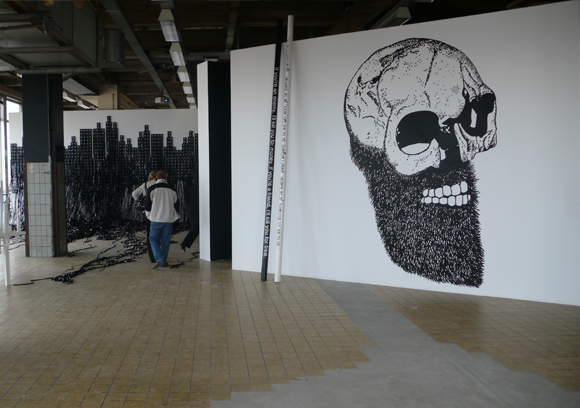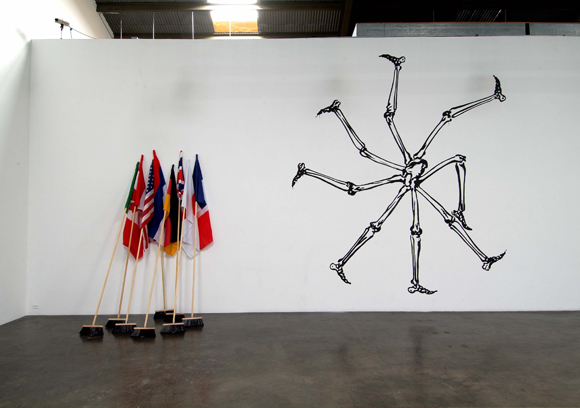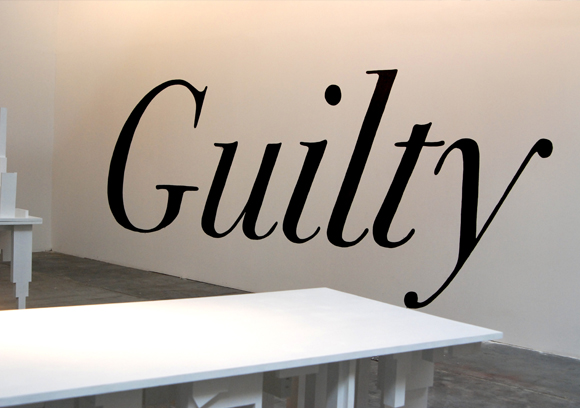| |
|
07.
 | The Mosque
| The Mosque |
| |

'' In fatmi’s wall painting The Mosque, a site of worship has been reduced to its foundations, the architecture leveled. But
within the floorplan that fatmi traces on a white gallery wall eternally symbolic forms arise - a black and white grid, a cross, a solid black square. ''
Lillian Davies, June 2010

Hard Head
Exhibition view from 180° Behind Me, Göteborgs Konsthall, 2018, Göteborg.
Courtesy of the artist and Ceysson & Bénétière, Paris.

Hard Head
Exhibition view from Traces du sacré, Centre Georges Pompidou, 2008, Paris.
Courtesy of the artist and Ceysson & Bénétière, Paris.

Dead or Alive
Exhibition view from Fuck architects : Chapter II, CAC Le Creux de l'Enfer, 2008, Thiers.
Courtesy of the artist.

The Great Forgiveness
Exhibition view from 1ere Biennale de Bruxelles, 2008, Brussels.
Courtesy of the artist.

The Cercle
Exhibition view from Something is possible, Shoshana Wayne Gallery, 2007, Los Angeles, 2007.
Courtesy of the artist.

Guilty
Exhibition view from Art, ecology and the politics of change, 8ème biennale de Sharjah, 2007, Dubaï.
Courtesy of the artist and Lawrie Shabibi, Dubai.
|
|
2009-2010, black acrylic painting, in situ.
Exhibition view from Seeing is believing, Galerie Hussenot, 2010, Paris.
Courtesy of the artist and Lawrie Shabibi, Dubai.
|
|
|
|
|
« La Mosquée » est une série de peintures murales qui reproduit en noir et blanc les plans architecturaux des mosquées traditionnelles, combinaison irrégulière de formes rectangulaires et légèrement inclinée par rapport au sol. Son esthétique rappelle celle du projet « Le Changement fondamental", succession graphique et chronologique de différents plans architecturaux, depuis ceux de mosquées construites au 9e siècle, jusqu'au plans des musées apparus dans les années 2000.
L'œuvre est une réflexion sur l'architecture et sur son rôle dans la transformation sociale des pays arabo-musulmans. Celle-ci est au cœur des recherches artistiques de mounir fatmi, menées à travers vidéos, photographies ou installations. L'architecture des pays arabo-musulmans a été marquée ces dernières années par l'apparition de vastes projets architecturaux, tels que le projet urbanistique Downtown Burj Khalifa qui a fait naître un nouveau quartier à Dubaï en innovant sur le plan des techniques du bâtiment. La construction de musées est également devenue prioritaire dans l'agenda culturel des ces pays. Ont ainsi vu le jour le musée national du Qatar, initialement appelé musée d'Art Islamique de Doha, conçu par l'architecte I.M. Pei, inauguré en 2008, ou le Louvre Abu Dhabi, réalisé par l'architecte Jean Nouvel et achevé en 2017.
La peinture murale « La Mosquée » transpose les plans de la mosquée traditionnelle dans le musée. Elle relie l'héritage architectural musulman à l'architecture contemporaine et observe leur dialogue. Une mise en dialogue effectuée également par I.M. Pei lors de l'élaboration du projet de musée d’art islamique au Qatar, désireux d'associer esthétique classique et modernité, dont la source d'inspiration essentielle provient de la mosquée Ahmed Ibn Touloun, édifice dont la construction remonte au 9e siècle. « La Mosquée » multiplie les expérimentations géométriques. La peinture murale retient la simplicité et la pureté des formes de l'architecture traditionnelle. L'efficacité fonctionnelle de ses formes rectangulaires est en effet susceptible de s'associer à l'esthétique de mouvements artistiques modernes, tels que le minimalisme et les courants abstraits. Le plan est inscrit directement sur les murs des salles d'exposition et signale la forte inscription sociale de l'architecture traditionnelle. L'œuvre s'inspire en effet des fonctions du lieu : elle n'est pas seulement un lieu de culte, elle est également un lieu où se tiennent des réunions de quartier, des formations, où se mènent des actions sociales à échelle locale.
L'œuvre de mounir fatmi s'interroge : la tradition peut-elle devenir la base architecturale de projets contemporains, peut-elle participer aux fondements d'une future identité culturelle ? L'inclinaison de la composition rectangulaire confère des allures de tour de Pise à ce plan de mosquée traditionnelle et rappelle peut-être son appartenance à un patrimoine culturel dont la sauvegarde et le renouvellement en sont les enjeux essentiels. La peinture murale « La Mosquée » insiste sur le rôle social des projets architecturaux et sur les enjeux politiques qui sous-tendent la construction des musées dans les pays arabo-musulmans, dont le fonctionnement implique une coopération avec les grands musées internationaux.
Studio Fatmi, Février 2017.
|
|
« The Mosque » is a series of wall paintings reproducing architectural plans of traditional mosques in black & white: an irregular combination of rectangular shapes, slightly inclined compared to the ground. Its esthetic is evocative of that of the project « The Fundamental Change », a graphic and chronological succession of different architectural plans, from those of 9th century mosques to the plans of museums built in the 2000s.
This piece is a reflection on architecture and its role in the social transformation of Arab Muslim countries. This subject is at the heart of mounir fatmi’s artistic research conducted through videos, photographs and installations. Architecture in Arab Muslim countries has been characterized these last few years by the emergence of large-scale architectural projects such as the urban project Downtown Burj Khalifa, that created an entire new neighborhood in Dubai, with innovative construction techniques. Building museums has also become a priority in the cultural agenda of these countries. The National Museum of Qatar, initially called the Doha Museum of Islamic Art, conceived by architect I.M. Pei and inaugurated in 2008, and the Louvre Abu Dhabi, designed by Jean Nouvel and completed in 2017, are two examples of this.?
The wall painting « The Mosque » transposes the plans of a traditional mosque into a museum. It connects the Muslim architectural heritage with contemporary architecture and observes the dialogue between them. This dialogue was also established by I.M. Pei during the elaboration of the Qatar museum of Islamic art, as he wished to associate a classic esthetic with modernity, his main source of inspiration being the Ahmed Ibn Touloun mosque built in the 9th century. « The Mosque » involves multiple geometric experimentations. The wall painting retains all the simplicity and purity of the shapes of traditional architecture. In fact, the functional efficiency of its rectangular shapes can be associated with the esthetic of modern artistic movements such as minimalism and abstract currents. The plan is drawn directly on the walls of the exhibition space and signals the strong social implication of traditional architecture. Indeed, the piece is inspired by the building’s functions: this not just a place of worship, it’s also a place where neighborhood meetings and training classes are held, and where social actions are conducted on a local scale. ?
mounir fatmi’s work poses the question: can tradition become the architectural foundation of contemporary projects, can it play a part in the foundation of a future cultural identity? The inclination of the rectangular composition gives this plan of a traditional mosque an aspect that is evocative of the tower of Pisa and perhaps reminds us that it belongs to a cultural heritage whose protection and renewal are essential questions. The wall painting « The Mosque » insists on the social role of architectural projects and on the political considerations behind the construction of museums in Arab Muslim countries, which require cooperation with major international museums to function.???
Studio Fatmi, February 2017.
|
|
|
|